NeurOptimal® for Home vs Professional Use: What’s the Difference?
NeurOptimal® for home vs professional use explained. Learn what’s the same, what’s different, and how to choose the right neurofeedback option.
Neurofeedback training is a widely used term but at its core it is a feedback system to let the individual use changes in brain wave activity as a source of feedback to potentially improve health and wellness.
Neurofeedback is a form of brain training that is also called neurofeedback therapy, neurobiofeedback, neurotherapy, and EEG biofeedback. Neurofeedback training is a widely used term but at its core it is a feedback system that uses the brainwaves, or the brain's electrical activity, to track and identify problems in the brain. Through non-invasive methods feedback is given so the brain can rewire and improve its health, mental and emotional performance.
-1.webp?width=900&height=492&name=neurofeedback-training-brain-map-(2)-1.webp)
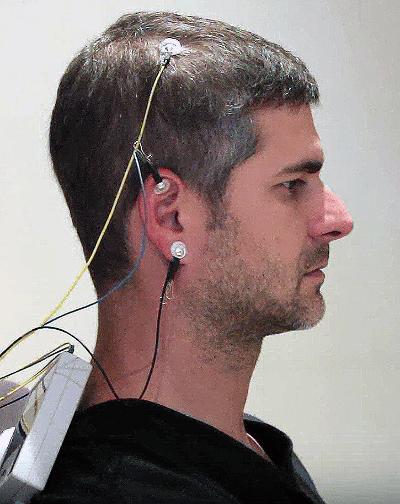 The term neurofeedback is broadly defined as any technique that aims to alter brain activity by making it perceptible to the senses in real time. This is often achieved by recording brain wave activity with an electroencephalography (EEG) and presenting that data audibly and visually.
The term neurofeedback is broadly defined as any technique that aims to alter brain activity by making it perceptible to the senses in real time. This is often achieved by recording brain wave activity with an electroencephalography (EEG) and presenting that data audibly and visually.
Recently, fMRI machines have used blood oxygenation levels of precise locations in the brain to collect the data about brain changes, This data is then fed back visually to the individual.
Once information is fed back, it is used either through conscious awareness to regulate state change in the brain, or unconsciously by the automatically functioning brain to improve habitual activity that is either ineffective or inappropriate for current needs.
There is debate amongst neurofeedback experts about the degree to which change is created on a conscious or on an unconscious level. Experts do agree that the essential aspect for change is that the feedback happens in real time.
Neurofeedback devices were developed from the discoveries made with biofeedback. Namely, that an individual can gain some control over involuntary functions and improve one's health by consciously intervening when the biofeedback tool noted certain changes in the body's state.
Common uses for biofeedback are to alter migraine pain, to manage general pain, and to manage stress. An example of biofeedback training is tracking your heart rate through a device and then using deep breathing to lower your heart rate by activating the parasympathetic nervous system, which controls the relaxation response and lowering heart rate.
With the development of neurofeedback, neuroscientists discovered that measuring and tracking the brain’s electrical activity, or brainwaves, was meaningful to help identify unhealthy brain activity and providing feedback about those patterns could be used as manage and impact brain performance.
Mental and emotional experiences are created by neurochemicals and electrical impulses or brain waves. When an individual performs tasks, those tasks are reflected in brainwave activity. They can be tracked when EEG sensors are attached to the head. For example, when an individual is performing a mental task such as problem-solving, Beta waves are dominant. When falling asleep, the slower Theta waves take over.
By tracking brain waves, we can see if the brain is not producing the correct brain wave activity to accomplish a task. For example, struggling to focus when trying to do school work or worrying when it’s time to fall asleep are signs that the brain is stuck in habitual patterns and are not in alignment with current needs.
Only recently has the speed of computing technology reached a level that could support neurofeedback devices because the brain performed functions much faster than old computers could track. Now, sophisticated hardware that can run at the speed of the brain’s computing and, therefore, track its functions in real-time.
Although neurofeedback has been called biofeedback, or EEG biofeedback, these two terms are different in their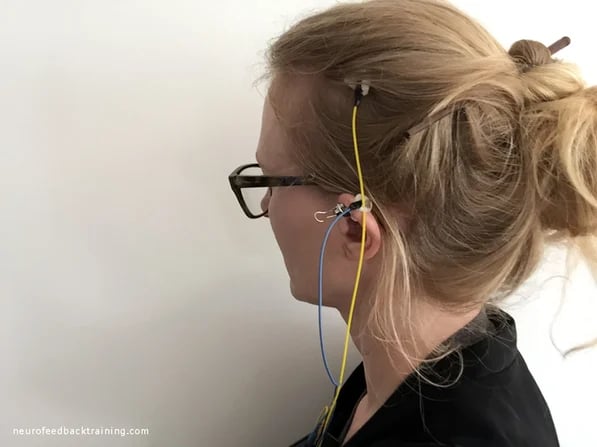 scope. Biofeedback involves measuring data from the whole body, while neurofeedback targets changes in the brain. Neurofeedback systems use a device to precisely measure brain changes, most commonly through monitoring brainwave frequencies. This alerts the individual to unconscious changes in the brain.
scope. Biofeedback involves measuring data from the whole body, while neurofeedback targets changes in the brain. Neurofeedback systems use a device to precisely measure brain changes, most commonly through monitoring brainwave frequencies. This alerts the individual to unconscious changes in the brain.
A significant difference between biofeedback and neurofeedback is how the client or trainee interacts with the equipment. With biofeedback devices. the user needs to engage their awareness and consciously shift a behaviour when alerted by the device. For example, in biofeedback, the individual may be alerted to an increase in heart rate. He would then use this information to actively practice deep breathing, which signals the parasympathetic nervous system to lower his heart rate.
With most neurofeedback devices, the theory is that the majority of the work is done by the unconscious part of the brain. The feedback from the brain wave activity is happening at the speed of microseconds. So, while the individual may be willfully doing something with the feedback, the automatic functioning brain - which can compute at the speed of microseconds - is using the feedback in real-time to shift its functioning.
Both systems rely only on real-time data about changes in the body. For example, muscle tension or the micro-shift in brainwave patterns.
A second commonality is the goal of shifting from physiological dysregulation to regulation. The most common 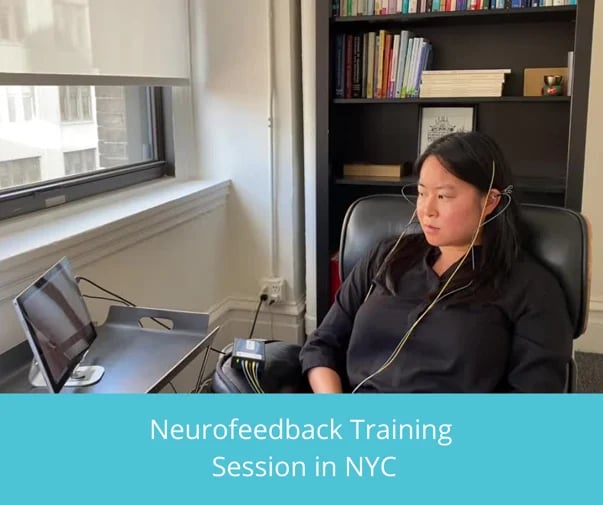 dysregulated state is the body being in a habitual stress response. The stress response is only supposed to be activated when the body is in a state of immediate danger. It is also known as the fight, flight or freeze response.
dysregulated state is the body being in a habitual stress response. The stress response is only supposed to be activated when the body is in a state of immediate danger. It is also known as the fight, flight or freeze response.
It is well known in the medical community that a chronic stress response lowers immunity and is connected with many degenerative illnesses such as heart disease, sleep disorders, anxiety and depression.
Regulation is bringing the body's functioning into a greater alignment with its current needs, in the current environment. Examples of regulation when the body is in a safe environment are a slower heart rate, relaxed muscle tone, deeper breathing or in the case of brainwave activities, an increase in alpha waves.
The current thinking in neurology is that the brain is designed as an information processing centre with the goal to make decisions accurately and most efficiently. When it is alerted to its own inefficiencies, the brain will automatically change its behaviour.
Neurofeedback therapy is another term for neurofeedback. It is the process of learning that happens over a series of 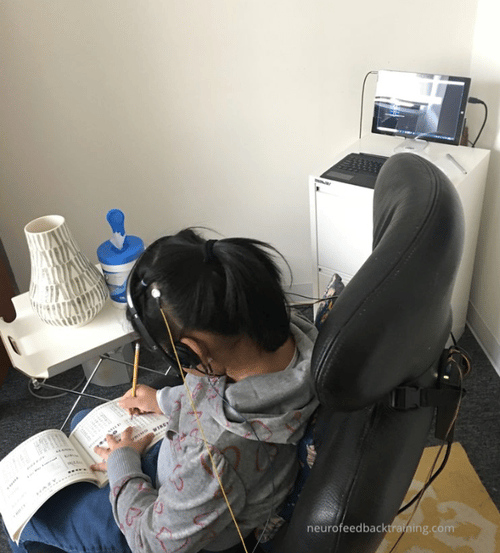 neurofeedback sessions. Neurofeedback is not a single event because the process of change in the brain happens over time and with repetition.
neurofeedback sessions. Neurofeedback is not a single event because the process of change in the brain happens over time and with repetition.
What can be trained? The brain makes most of its decisions about internal body needs and external environmental needs unconsciously and automatically. Many of those decisions are habitual. Some are constructive and some are not. An example of an unconstructive habit is when someone yells in anger and then says, “I didn’t mean to do that. I just found myself yelling.”
That reactivity is a decision made by the brain on an unconscious level. It is an automatic reaction that most often is not the most appropriate or effective response to the current situation.
Through neurofeedback training, the individual learns to identify and change how it automatically reacts. With anything that is a habit, repetition of the new behaviour over a period of time is necessary to establish a new pattern.
Since its inception in the 1970s, neurofeedback machines have worked by measuring the real-time activity of the brain, most frequently the electrical activity, or voltage, as measured in Hertz. More recently, MRI neurofeedback that measures oxygen-level changes in the blood to record neural activity have been developed.
EEG neurofeedback places sensors on the scalp and through the use of conductive paste the brain wave activity is 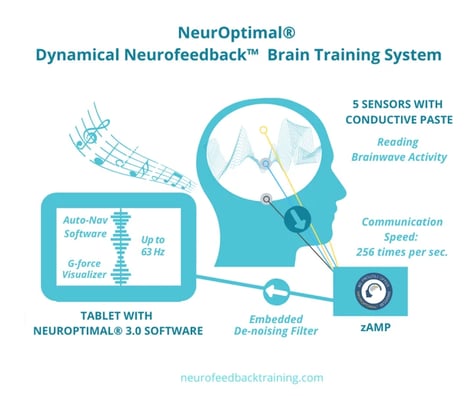 collected and sent to an amplifier that changes the voltage into numbers. Those numbers are then sent into a computer device. The computer is installed with software that has mathematical formulations to take the brain activity numbers and translate them into brainwave frequencies, such as Alpha, Beta, Theta, etc. They are ranges of electrical activity associated with different states. For example, Theta frequencies are active when people sleep, and Alpha brain waves occur when they are doing mental tasks.
collected and sent to an amplifier that changes the voltage into numbers. Those numbers are then sent into a computer device. The computer is installed with software that has mathematical formulations to take the brain activity numbers and translate them into brainwave frequencies, such as Alpha, Beta, Theta, etc. They are ranges of electrical activity associated with different states. For example, Theta frequencies are active when people sleep, and Alpha brain waves occur when they are doing mental tasks.
Different neurofeedback software uses proprietary mathematical formulas to compute the meaningful change in the brain. Electrical impulses travel along the brain’s neurons at varying speeds but can reach 270 miles per second. At this speed, the software would then use auditory and/or visual cues to alert the individual to a change in the brain.
There are two broad categories of neurofeedback devices: linear, also called protocol-based, and Dynamical also called non-linear.
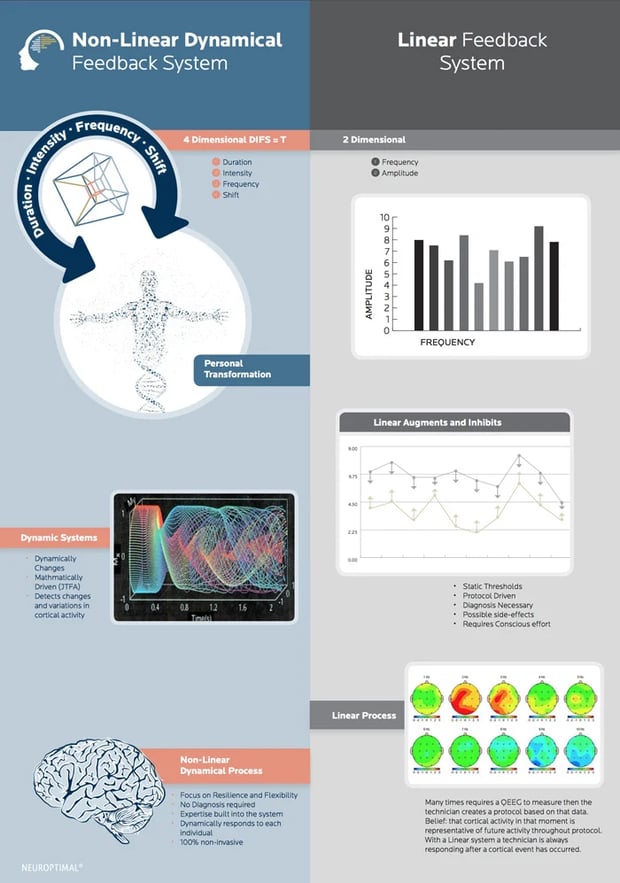
Linear neurofeedback was the first generation of devices and is called EEG biofeedback systems. They work by 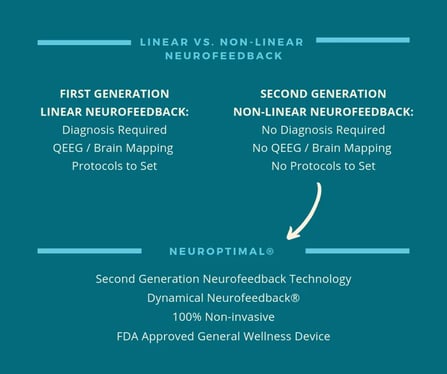 having a neurofeedback trainer first take a map of the brain’s electrical patterns. This map allows the trainer to analyze brain activity. For example, looking to see if their Theta brainwaves are low or Alpha too high in comparison with the patterns of a healthy brain. This mapping is called a qEEG- Qualitative Electroencephalography. Recorded electrical activity of the brain is used to generate a map of brain function.
having a neurofeedback trainer first take a map of the brain’s electrical patterns. This map allows the trainer to analyze brain activity. For example, looking to see if their Theta brainwaves are low or Alpha too high in comparison with the patterns of a healthy brain. This mapping is called a qEEG- Qualitative Electroencephalography. Recorded electrical activity of the brain is used to generate a map of brain function.
The map is then used as a reference point for the trainer to set protocols to help the brain to migrate towards normal and healthier brain wave patterns. When a brain map is not available, the clinician may use a diagnosis such as ADHD or anxiety to set the protocols.
Brainwave lengths represent measurements of the brain's electrical voltage, which is translated through mathematics into different frequencies. These frequencies have names, such as Theta, Beta, or Alpha, and are associated with different brain functions or states.
For example, based on your brain map, the clinician might assess that a client has too much Delta wave activity and not enough Alpha wave activity. She will create protocols to help the brain shift in those frequencies and will use client self-reports and mapping results to assess progress from session to session. A series of sessions will bring the client closer to optimal brain wellness.
There are a number of devices on the market, including EEGer, Cygnet, Lens, Brainasium, LoReta, and BrainPaint. Except for Cygnet, all require a brain map assessment or diagnosis before training can begin.
With linear brain training, a client relies on the skills of the clinician, who establishes a protocol program and adjusts it over a series of sessions. Errors in adjusting frequencies- i.e. over or under the training of different frequencies- can create side effects. The skill of the clinician is very important to consider with linear neurofeedback.
The second generation of neurofeedback devices arose as the speed of computing power approached the speed of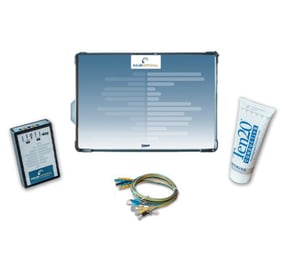 the brain’s processing. The design of this system is referred to as non-linear due to the mathematical formula used, which mirrors how the brain naturally creates change. The brain’s method of change and improvement is a non-linear systemic approach.
the brain’s processing. The design of this system is referred to as non-linear due to the mathematical formula used, which mirrors how the brain naturally creates change. The brain’s method of change and improvement is a non-linear systemic approach.
What is a linear system versus a non-linear system? Anything that functions with 100% predictability is a linear system. An example of a non-linear system of change is the weather. We understand that winter leads to spring, summer and fall (linear system) but it doesn’t do so with a predictable pattern of temperature increase and decrease (non-linear). Snowfall in April does not mean that we are heading back to winter!
The brain also changes in a non-linear pattern and the mathematical formulation for the software of non-linear neurofeedback mirrors this pattern. Specifically, the software looks at the brain’s electrical activity or voltage and determines state change by factoring in the changes in duration, amplitude, and frequencies over time.
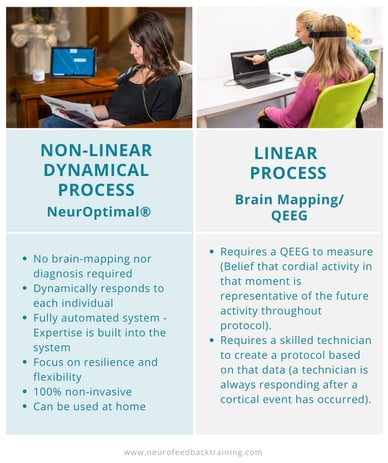 Another significant difference with non-linear neurofeedback is that it does not require the trainer to set protocols. Because the speed of computing has approached brain speed, the dynamical software interacts with the brain in real-time to give it feedback so that the individual’s brain can register its own state changes and shift anything that is not optimal.
Another significant difference with non-linear neurofeedback is that it does not require the trainer to set protocols. Because the speed of computing has approached brain speed, the dynamical software interacts with the brain in real-time to give it feedback so that the individual’s brain can register its own state changes and shift anything that is not optimal.
The software takes hundreds of data points from the electrical activity measured by the EEG sensors per second. The device then uses micro-interruptions in music that is playing while the training session is running.
Hearing is the main sense perception that the brain uses to detect changes in the environment. The precisely-timed interruptions act as an alert system telling the individual brain to pay attention to two sets of information: what is happening externally in the environment and what is happening internally in the body.
The training is giving this feedback thousands of times per session. The individual brain can then use this feedback to see its own automatic choices or habits and then decide if it wants to change those patterns.
The theory behind nonlinear neurofeedback training is that over the period of training sessions the process of learning which takes place results in the most efficient and effective use of energy by the brain to respond to current environmental needs. This process of gathering current data replaces maladaptive habitual responses. Once the brain has learned this new pattern of assessing needs, the individual notices changes in mental and emotional reactions.
Currently there is only one non-linear, dynamical neurofeedback system on the market, NeurOptimal®, made by Zengar Institute.
Although not a technically feedback system, microcurrent stimulation devices are often called neurofeedback. Microcurrent stimulation devices work by sending a mild stimulation to the cranial nerve.
The FDA just approved the first device, called Monarch eTNS, for the treatment of Attention Deficit Hyperactivity Disorder (ADHD).
The scope of neurofeedback is broad and multifaceted, reflecting the brain's pivotal role in orchestrating a wide array of mental functions. 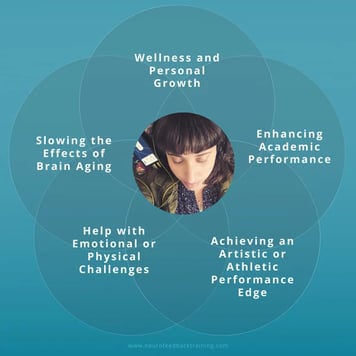
Neurofeedback's applications can be broadly categorized into addressing specific symptoms or conditions and enhancing overall wellness and cognitive functionality. Among its most common uses are the support and management of emotional regulation challenges, such as those experienced with anxiety, depression or trauma. It also plays a crucial role in aiding individuals with learning and developmental delays, notably in cases of ADHD (Attention-Deficit/Hyperactivity Disorder) and Autism Spectrum Disorder (ASD), where it offers a non-pharmacological option as brain training to help manage symptoms and improve quality of life.
Furthermore, neurofeedback has shown promise in assisting with the recovery from head injuries, providing a tool for rehabilitation that can complement traditional medical treatments by promoting neuroplasticity and aiding in the re-establishment of healthy brain wave patterns. Additionally, individuals seeking peak performance, whether in academics, professional fields, or sports, find neurofeedback an invaluable resource for enhancing concentration, decision-making, and stress resilience, thereby optimizing their mental and physical performance.
Stress-related issues, which can encompass a wide range of symptoms from sleep disturbances to chronic anxiety, are another area where neurofeedback has been effectively employed. By training the brain to modulate its response to stress and improve self-regulation, individuals can achieve a more balanced and healthier state of mind.
For neurofeedback systems that have been approved by the FDA as Medical Devices or are under investigation for such approval, there is a targeted approach to alleviating symptoms associated with specific disorders, including the ones mentioned. Manufacturers are tasked with registering their devices with the FDA, which then evaluates these systems to classify them either as Class 2 Medical Devices or as General Wellness Devices, based on the intended use claimed by the manufacturer—be it for therapeutic treatment or cognitive training.
Devices categorized as General Wellness Devices by the FDA are recognized as safe for public use without medical supervision. These devices are primarily aimed at brain training for enhancing overall wellness rather than treating medical conditions, making them accessible tools for individuals looking to improve their mental well-being and cognitive capabilities.
In essence, neurofeedback stands out for its capacity not only to offer relief from specific health conditions but also to facilitate a pathway toward enhanced mental wellness and cognitive performance. As research progresses and technology advances, the applications of neurofeedback are expected to broaden even further, solidifying its role as a versatile and effective tool. This expansion underscores neurofeedback's potential to transform lives by improving emotional regulation, aiding in recovery from injuries, and helping individuals achieve their peak performance levels.
Natalie Baker has over 25 years of experience as a licensed psychotherapist and has been a NeurOptimal® neurofeedback trainer since 2011. She is the founder of Neurofeedback Training Co., which offers in-person sessions and runs the largest nationwide home rental program for NeurOptimal systems. Natalie also teaches meditation and Buddhist psychology and specializes in working with anxiety, stress, ADHD, and trauma.
NeurOptimal® for home vs professional use explained. Learn what’s the same, what’s different, and how to choose the right neurofeedback option.
Mindfulness can be a powerful tool for managing anxiety. Learn how to use mindfulness for anxiety and performance in our latest blog post.
Does neurofeedback work? Is it a placebo effect? Learn the difference between non-linear and linear neurofeedback and the signs when it's working and...
Be the first to know about new blogs